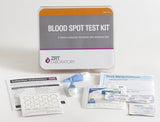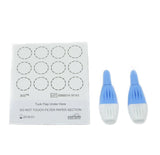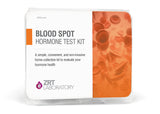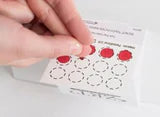Elite Thyroid + Vitamin D (D2 &D3) Profile Test is designed for testing 8 following essential hormones and vitamins:
- Thyroglobulin (Tgbn),
- Thyroid Stimulating (TSH),
- Free Triiodothyronine (fT3),
- Free Thyroxine (fT4),
- Thyroid Peroxidase Antibody (TPO)
- Thyroxine (t4)
- Vitamin D2& D3
Test Result: You will receive your test result 3-5 working days after the laboratory receives your sample. You will see your hormone levels in graphics and numbers on your test results. You will also see laboratory comments by Hormone Specialist PhD Dr in the comments: you will find an analysis of your hormone levels and what to do next.
- Collect samples from the comfort of your home and post them to our lab.
- The test must be used within 12 months after the purchase date.
- The test kit includes a laboratory fee: no additional laboratory cost or tax.
- Customers are responsible for shipping their samples to the laboratory.
The Elite Thyroid and Vitamin D Blood Spot Profile will give you a complete assessment of thyroid and Vitamin D health. This includes checking for hypothyroidism or hyperthyroidism and monitoring dosages for thyroid replacement. Thyroglobulin to address low iodine status, testing for autoimmune thyroid disease, and quantifying the total T4 produced by the thyroid.
If you are experiencing any of the below symptoms, this test is recommended.
Symptoms of thyroid problems include:
- Weight gain or inability to lose weight even with exercise and diet
- Weight loss
- Feeling cold all the time when others don’t
- Low energy and stamina (mostly in the evening)
- Irregular bowel habits – constipation/loose stools
- Dry, thinning, and itchy skin
- Hair loss, Dry/brittle hair and nails
- Depression, Insomnia
- Water retention
- Menstrual irregularities
- Low sex drive, Infertility
- Memory lapses or slow/fuzzy thinking
- Osteoporosis
- Muscle and joint aches and pains
- High blood pressure, Increased cholesterol levels
- Heat or cold intolerance
Symptoms of Vitamin D problems include:
Disorders linked with vitamin D deficiency include:
- Stroke,
- Flu,
- Cardiovascular disease,
- Osteoporosis,
- Osteomalacia,
- Several forms of cancer,
- Some autoimmune diseases, such as multiple Sclerosis,
- Rheumatoid Arthritis,
- Type I Diabetes & Type II Diabetes,
- Breast and Colon Cancer (linked to Vitamin D Deficiency),
- Depression and even schizophrenia.
Thyroid Hormone Imbalance
Thyroid disease or dysfunction can explain a wide variety of symptoms (see list below), yet it is notoriously underdiagnosed. The Colorado Thyroid Disease Prevalence Study published in 20001 found that 9.9% of the study population consisted of people who were not treated for thyroid problems yet had abnormal thyroid function test results. This suggests that their thyroid disease was previously undiagnosed. This study also found a significantly greater incidence of thyroid dysfunction in women than in men in each decade after the age of 34. The American Thyroid Association estimates that over 12% of the US population will develop thyroid disease during their lifetime and that as many as 60% of people with thyroid disease are not aware of it2. Overt hypothyroidism, with its characteristically high TSH and low circulating T4 levels, and hyperthyroidism, with low TSH and high T4 levels, are easy to recognise clinically. But an elevated TSH associated with normal thyroid hormone (T3 and T4) levels, defined as “subclinical” hypothyroidism, is thought to be present in 4-10% of the general population and in up to 20% of women over 60 years old; and a low TSH with normal T3 and T4 levels, subclinical hyperthyroidism, occurs in about 2% of the population and is most common in women, blacks, and the elderly3.
TSH – Thyroid Stimulating Hormone
The pituitary produces TSH. TSH acts on the thyroid gland to stimulate the production of the thyroid hormones T4 and T3. Higher than normal TSH can indicate overproduction of or excessive supplementation with T4 and/or T3, Which acts in negative feedback on the pituitary to reduce TSH production. Low TSH can also be caused by problems in the pituitary gland itself, resulting in insufficient TSH to stimulate the thyroid (secondary hypothyroidism).
Free T4- Thyroxine
The predominant hormone is produced by the thyroid gland. It is an inactive hormone and is converted to its active form, T3, within cells. Free T4 is the non-protein bound fraction of the T4 circulating in the blood, representing about 0.04% of the total circulating T4, which is available to tissues. Low TSH combined with low T4 levels indicates hyperthyroidism. High TSH and low T4 abdicate a thyroid gland disease, such as autoimmune thyroiditis (Hashimoto’s).
Total T4 – Thyroxine
Total T4 includes both free T4 and protein-bound T4 and, therefore represents the thyroid gland’s capacity to synthesise, process, and release T4 into the bloodstream. In contrast, free T4 represents only bioavailable circulating hormone and is tightly complexed with thyroid-binding globulin (TBG). Certain conditions, like oral estrogen usage or pregnancy, can
cause total levels to change due to liver induction of TBG. However, this can result in no change in free T4 or lower bioavailable levels of free T4 even though total T4 increases.
Free T3 – Triiodothyronine
The active thyroid hormone regulates the metabolic activity of cells. Free T3 is the non-protein-bound fraction circulating in the blood, representing about 0.4% of the total circulating T3, which is available to tissues. Therefore, elevated T3 levels are seen in hyperthyroid patients, but levels can be normal in hypothyroid patients because it does not represent the intracellular conversion of T4 to T3, which comprises about 60% of all T3 formed in tissues.
TPOab – Thyroid Peroxidase Antibodies
Thyroid peroxidase is an enzyme used by the thyroid gland in the manufacture of thyroid hormones by liberating iodine for attachment to tyrosine residues on thyroglobulin. In patients with autoimmune thyroiditis (predominantly Hashimoto’s disease), the body produces antibodies that attack the thyroid gland, and levels of these antibodies in the blood can diagnose this condition and indicate the extent of the disease.
Thyroglobulin (Tgbn)
A protein that is rich in tyrosine and synthesised only in the thyroid gland. When bound to iodine, tyrosine residues in thyroglobulin become the source material for the synthesis of the thyroid hormones T3 and T4. When iodine levels are low, high levels of thyroglobulin can be found in the blood as iodine-poor thyroglobulin builds up and leaks from the thyroid into the bloodstream. Levels of thyroglobulin are an indicator of a person’s average iodine exposure over a period of weeks: the
greater the iodine exposure, the lower the thyroglobulin level. Elevated thyroglobulin, in the absence of more serious thyroid diseases such as thyroid cancer, which results in very high blood thyroglobulin levels, indicates low iodine status.
Elements that Affect Thyroid Function
We are all, to varying degrees, depending on our dietary choices, our supplementation routine, or our lifestyle, exposed to the elements iodine, bromine, selenium, arsenic, and mercury. Levels of these elements in the food we eat are determined by soil levels and other environmental exposure of plants and animals that end up in the food chain and, ultimately, on our dining tables. We can also be directly exposed to elements through environmental pollution of the air we breathe and exposure through our skin. How does exposure to these elements affect health? Iodine is an essential component of T3 and T4, so its deficiency seriously impacts hormone synthesis. Bromine is in the same chemical family as iodine, and excessive amounts will compete with iodine in the thyroid. Selenium is a component of the selenoproteins, including the iodothyronine deiodinases, which convert inactive T4 to its active form in the body (T3), and glutathione peroxidase, which prevents free radical damage to the thyroid by destroying the hydrogen peroxide that is a by-product of thyroid hormone synthesis. Arsenic and mercury are toxic heavy metals that form tight complexes with selenium and, therefore, reduce selenium’s bioavailability, resulting in biological effects similar to selenium deficiency, including disruption to thyroid health. While bromine, arsenic, and mercury are known biological toxins, even iodine and selenium can potentially be toxic if dietary intake, including excessive supplementation, is too high.
Cause of Vitamin D Deficiency
A major cause of vitamin D deficiency is not getting enough sun.
This happens because people don’t spend much time outdoors. Women, in particular, often have much of their skin area covered for cultural reasons. The use of sunscreen also blocks the formation of vitamin D in the skin.
Why Vitamin D Deficiency Test?
Testing for vitamin D is an important screening test, especially if you spend much of your time indoors or live in a colder climate. This blood spot test measures both the natural form of Vitamin D (D3) and D2, the form used in many supplements. So, testing can be used to monitor vitamin D supplementation to ensure you are getting the right amount for optimum health.
Who is at Risk?
The Elderly
Amounts of the vitamin D originator in the skin decrease with age; therefore, older people are particularly prone to deficiency, and living in rest homes or becoming home-bound can limit exposure to sunshine. In addition, muscle weakness and osteoporosis associated with vitamin D deficiency make the elderly more susceptible to falling and fracture risk, and studies show that vitamin D supplementation may decrease the risk of fractures.
Dark-Skinned People
Because people with darker skin have higher levels of melanin, which can block the action of sunlight on vitamin D originators, they may require much longer exposure to sunlight than people who are fair-skinned.
People with Limited Sunlight Exposure
People living in northern latitudes or with limited sunlight exposure because of their working environment or cultural dress rules may have low vitamin D levels.
Musculoskeletal Pain Sufferers
People with hypothyroidism, non-specific musculoskeletal pain, chronic low back pain, or fibromyalgia symptoms frequently have low vitamin D levels. However, after supplementation, the improvement has been shown during clinical research. Therefore, vitamin D screening is strongly recommended in muscle and joint pain patients.
Overweight or Obese People
Vitamin D can be locked up in the fat stores of obese people, who have been found to have lower levels of circulating vitamin D and are at risk of deficiency.
Breast-fed infants and Children with Limited Sunlight Exposure
All children require adequate circulating vitamin D to prevent rickets. Dark-skinned children and those who spend much of the day inside daycare centres are at risk of deficiency, and breastfed children often receive inadequate amounts of vitamin D, mainly when their mothers are deficient. Giving vitamin D supplements to the nursing mother or the use of cod liver oil or other vitamin D supplements in infants and children can reduce the risk of developing type I diabetes in childhood.
Vitamin D screening has been recommended as a routine part of the annual physical examination. Deficiency does not have obvious symptoms but increases your risk for more serious diseases.
Clinical Utility
Blood spot testing for Vitamin D can help your doctor:
• Identify vitamin D deficiency as a potential cause of health problems – levels below 20 ng/mL indicate a deficiency, while levels below 32 ng/mL are “low”; optimal levels are 32-100 ng/mL (research is ongoing to establish definitive recommendations)
• Recommend the right dose of vitamin D as a supplement and monitor your D levels during
Supplementation to ensure you have adequate levels without overdosing – toxicity may be expected at levels >150 ng/mL
• Recommend appropriate ways to safely increase sunlight exposure and modify your diet to include more vitamin D-containing foods and supplements
• Track treatment progress with follow-up testing
How is the test carried out?
This blood spot-based testing tool can be done in the privacy of your home. A simple step of collecting your blood spot for the test is required. Once you provide a blood spot, you must seal the sample and send it to us. Your test result report will be emailed to you between 3 and 5 working days after the laboratory receives your sample.
Advantages of a Simple Blood Spot Test
- No phlebotomist or centrifugation is required; therefore, it is less expensive and more convenient than conventional blood draws
- A nearly painless finger stick is used to collect the few drops of blood required
- Private and convenient for both patient and healthcare provider - collection at home or provider’s office
- Hormones and other analyses are stable in dried blood spots at room temperature for weeks, allowing for worldwide shipment
- Safe handling and transport of samples, as infectious agents are destroyed by drying










